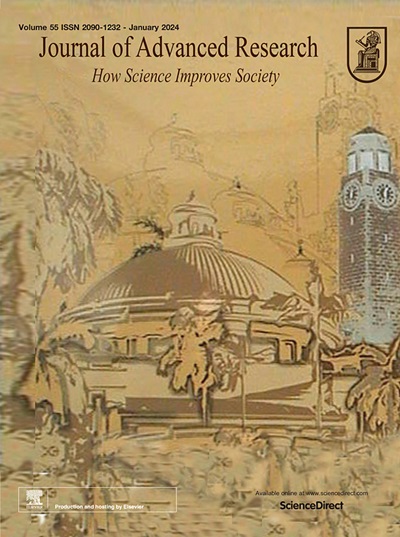SUMOylation modulates the dual functions of Krüppel homolog 1 in transcriptional regulation of Broad-Complex expression
IF 13
1区 综合性期刊
Q1 MULTIDISCIPLINARY SCIENCES
引用次数: 0
Abstract
Introduction
Insects undergo intricate metamorphosis processes governed by hormonal regulatory mechanisms, exemplified by the antagonistic actions of 20-hydroxyecdysone (20E) and juvenile hormone (JH). Krüppel homolog 1 (Kr-h1) is a key transcription factor mediating JH’s antagonistic effects on 20E. Previous studies have shown that Kr-h1 plays dual roles in regulating the 20E signaling gene Broad-Complex (Br-C), repressing it in larvae and activating it during pupation. However, the mechanisms underlying this dual functionality remain elusive.Objectives
This study aimed to determine whether SUMOylation, a post-translational modification, functions as part of a molecular switch mechanism for Kr-h1’s stage-specific transcriptional roles.Methods
Using Drosophila melanogaster, we analyzed Kr-h1 SUMOylation dynamics via Western blot, immunoprecipitation combined with Drosophila genetics. Immunostaining, RT-qPCR, and luciferase reporter assays were performed to investigate the impact of SUMOylation on the bidirectional transcriptional regulation of Kr-h1 on Br-C. SUMOylation sites were identified through mutagenesis and bioinformatics. Coimmunoprecipitation and mass spectrometry explored Kr-h1 interactors. Hormonal effects on regulation of Kr-h1 SUMOylation were tested using JH mimic (methoprene) and 20E treatments.Results
Kr-h1 undergoes stage-specific SUMOylation: it is highly SUMOylatedin early third-instar larvae, enabling interaction with the histone methyltransferase SmydA-8 to repress Br-C. Conversely, at the white prepupal stage, deSUMOylation disrupts the Kr-h1- SmydA-8 interaction, thereby activating Br-C expression. K113 was identified as the primary SUMOylation site in Kr-h1. JH stimulated Kr-h1 SUMOylation by enhancing its interaction with the SUMO-conjugating enzyme Ubc9. Conversely, 20E promotedKr-h1 deSUMOylation via increased association with the deSUMOylating enzyme ubiquitin-like protease 1 (Ulp1). Co-stimulation with JH and 20E synergistically amplified deSUMOylation.Conclusion
SUMOylation of Kr-h1 serves as a molecular switch governing its dual regulatory functions in Br-C expression. JH and 20E antagonistically control this post-translational modification. Our study establishes SUMOylation as a critical regulator of Kr-h1’s stage-specific activity, revealing how it orchestrates crosstalk between JH and 20E signaling during insect development. These findings provide a mechanistic framework for understanding how post-translational modifications confer functional plasticity to transcription factors at pivotal developmental transitions. Moreover, identifying SUMOylation as a central node in JH/20E crosstalk opens new avenues for targeting this pathway in insect growth regulators for pest management.

SUMOylation调节kr ppel同源物1在广泛复合物表达转录调控中的双重功能
昆虫经历了复杂的变态过程,受激素调节机制的控制,例如20-羟基蜕皮激素(20E)和幼体激素(JH)的拮抗作用。kr ppel同源物1 (Kr-h1)是介导JH对20E拮抗作用的关键转录因子。已有研究表明,Kr-h1在调控20E信号基因Broad-Complex (Br-C)中发挥双重作用,在幼虫体内抑制Br-C,在化蛹过程中激活Br-C。然而,这种双重功能背后的机制仍然难以捉摸。本研究旨在确定SUMOylation(一种翻译后修饰)是否作为Kr-h1特异性转录作用的分子开关机制的一部分。方法以黑腹果蝇为研究对象,采用Western blot、免疫沉淀结合果蝇遗传学方法分析其Kr-h1 summoylation的动态。通过免疫染色、RT-qPCR和荧光素酶报告基因检测来研究SUMOylation对Kr-h1对Br-C的双向转录调控的影响。通过诱变和生物信息学鉴定了SUMOylation位点。共免疫沉淀和质谱法研究了Kr-h1相互作用物。采用JH模拟物(甲基戊二烯)和20E处理检测激素对Kr-h1 summoylation的调节作用。结果skr -h1经历了特定阶段的SUMOylation:在早期三龄幼虫中高度SUMOylation,能够与组蛋白甲基转移酶SmydA-8相互作用以抑制Br-C。相反,在白色预蛹阶段,deSUMOylation破坏了Kr-h1- SmydA-8的相互作用,从而激活了Br-C的表达。K113被确定为Kr-h1的主要SUMOylation位点。JH通过增强其与sumo偶联酶Ubc9的相互作用来刺激Kr-h1的sumo化。相反,20E通过增加与去苏酰化酶泛素样蛋白酶1 (Ulp1)的关联,促进了kr -h1的去苏酰化。与JH和20E共刺激可协同放大去苏甲基化。结论Kr-h1的summoylation在Br-C表达中起着双重调控作用。JH和20E对抗性地控制这种翻译后修饰。我们的研究确定了SUMOylation是Kr-h1阶段特异性活性的关键调节因子,揭示了它如何在昆虫发育过程中协调JH和20E信号传导之间的串扰。这些发现为理解翻译后修饰如何在关键的发育转变中赋予转录因子功能可塑性提供了一个机制框架。此外,确定SUMOylation是JH/20E串扰的中心节点,为昆虫生长调节剂中针对这一途径进行害虫管理开辟了新的途径。
本文章由计算机程序翻译,如有差异,请以英文原文为准。
求助全文
约1分钟内获得全文
求助全文
来源期刊

Journal of Advanced Research
Multidisciplinary-Multidisciplinary
CiteScore
21.60
自引率
0.90%
发文量
280
审稿时长
12 weeks
期刊介绍:
Journal of Advanced Research (J. Adv. Res.) is an applied/natural sciences, peer-reviewed journal that focuses on interdisciplinary research. The journal aims to contribute to applied research and knowledge worldwide through the publication of original and high-quality research articles in the fields of Medicine, Pharmaceutical Sciences, Dentistry, Physical Therapy, Veterinary Medicine, and Basic and Biological Sciences.
The following abstracting and indexing services cover the Journal of Advanced Research: PubMed/Medline, Essential Science Indicators, Web of Science, Scopus, PubMed Central, PubMed, Science Citation Index Expanded, Directory of Open Access Journals (DOAJ), and INSPEC.
 求助内容:
求助内容: 应助结果提醒方式:
应助结果提醒方式:


